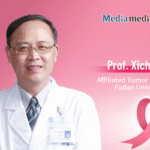
Editor’s Note: CDK4/6 inhibitors (CDK4/6i) have become an important therapeutic option for hormone receptor–positive, HER2–negative (HR+/HER2-) breast cancer, yet there remains room for improvement in efficacy and safety. Recently, the China NMPA officially approved the novel CDK4/6 inhibitor Lerociclib for two indications in adult patients with locally advanced or metastatic HR+/HER2- breast cancer:
- In combination with an aromatase inhibitor (AI) as initial endocrine therapy, and
- In combination with fulvestrant for disease progression after prior endocrine therapy.
In this interview, Professor Jianghua Ou of Xinjiang Medical University Affiliated Cancer Hospital discusses the evolution and optimization of the CDK4/6 inhibitor class, interpreting Lerociclib’s pharmacologic innovations, clinical evidence, and future role in China’s breast cancer landscape.
01. Optimizing Efficacy and Reducing Toxicity — The Next Stage in CDK4/6 Inhibitor Development
Oncology Frontier: CDK4/6 inhibitors are critical in HR+/HER2- breast cancer treatment but still have certain adverse effects or efficacy limitations. What new mechanisms or design strategies may achieve better efficacy with fewer side effects?
Prof. Jianghua Ou: CDK4/6 inhibitors combined with endocrine therapy (CDK4/6i + ET) have become central to the systemic treatment of HR+/HER2- breast cancer—spanning from high-risk early-stage adjuvant therapy to first- and second-line therapy for advanced disease. In addition, newer targeted agents such as PI3K inhibitors are being evaluated in combination with CDK4/6i + ET, further reshaping the treatment paradigm.
The overarching goals for advanced disease are to prolong survival and maintain or improve quality of life. Although current CDK4/6 inhibitors have established efficacy and safety, specific toxicities remain—such as neutropenia, anemia, diarrhea, venous thromboembolism (VTE), interstitial lung disease (ILD), QT prolongation, and elevated liver enzymes. Even if infrequent, these adverse events can compromise quality of life and increase the burden of clinical monitoring.
Moreover, for patients with high tumor burden (e.g., visceral crisis), endocrine therapy alone may act too slowly, necessitating chemotherapy rescue. Thus, while CDK4/6 inhibitors remain “star agents” in HR+/HER2- breast cancer, their mechanistic diversity and toxicity differences necessitate personalized selection—for example, considering cardiac history or gastrointestinal tolerance when choosing a CDK4/6i. At the same time, further optimization of efficacy, safety, and tolerability remains an active area of drug development.
02. Lerociclib: A New-Generation CDK4/6 Inhibitor with Structural and Mechanistic Innovations
Oncology Frontier: The newly approved Lerociclib, co-developed internationally, has attracted attention. What key pharmacologic advantages distinguish it from earlier CDK4/6 inhibitors?
Prof. Jianghua Ou: Lerociclib is a new-generation CDK4/6 kinase inhibitor, first presented by Professor Xu Binghe at the 2023 ASCO Annual Meeting. Its main advantages are as follows:
- Innovative molecular design: Lerociclib features a tricyclic and spiro-ring structure, unlike traditional CDK4/6 inhibitors. Kinase profiling shows high selectivity for CDK4, with a remarkably low half-maximal inhibitory concentration (IC50), indicating potent inhibition of CDK4 and CDK6 while minimizing off-target effects.
- High tissue penetration: Lerociclib demonstrates tumor tissue exposure 18 times higher than plasma exposure. Even 24 hours after administration—when plasma concentrations are very low—tumor concentrations remain more than 100 times higher, supporting sustained inhibition within the tumor microenvironment.
- Strong clinical efficacy: Across two Phase III studies, Lerociclib achieved progression-free survival (PFS) hazard ratios (HRs) of approximately 0.4, representing significant improvement versus controls.
- Low discontinuation rate: In the LEONARDA clinical program, the treatment discontinuation rate due to adverse events was only 0.7%.
These four features—high selectivity, high tissue penetration, high clinical benefit, and low discontinuation—stem directly from its advanced molecular design and make Lerociclib one of the most effective CDK4/6 inhibitors currently approved in China.
03. Robust Clinical Evidence — Lerociclib’s Efficacy and Safety in Key Phase III Trials
Oncology Frontier: Lerociclib’s two newly approved indications are based on the LEONARDA-1 and LEONARDA-2 studies. Could you summarize their evidence and main findings?
Prof. Jianghua Ou: Lerociclib’s approvals in May 2025 were supported by two Phase III randomized controlled trials designed specifically for Chinese patients:
- LEONARDA-2: First-line treatment population
- LEONARDA-1: Endocrine-pretreated population
Both trials enrolled premenopausal and postmenopausal women, including patients with visceral metastases, high tumor burden (≥3–4 metastatic sites), and other high-risk features, reflecting real-world Chinese clinical practice. This is particularly important as the median age of breast cancer onset in China is roughly a decade earlier than in Western populations, and many young patients present with aggressive disease.
Both studies demonstrated consistent and significant PFS improvement, with HR values around or below 0.5—among the lowest reported globally. Lerociclib provided strong benefit even in difficult-to-treat subgroups such as those with liver metastases or multiple organ involvement.
In terms of safety, Lerociclib showed a favorable tolerability profile:
- Grade 4 neutropenia occurred in only 5.1% of patients.
- No ≥Grade 3 diarrhea was observed (only one Grade 3 case in LEONARDA-2).
- No ILD, VTE, or other special toxicities were reported.
- The incidence of QT prolongation was comparable to placebo.
Together, these data reaffirm Lerociclib’s balanced efficacy and safety, with minimal discontinuations and strong clinical relevance for Chinese patients.
04. Clinical Outlook — Expanding Access and Transforming the HR+/HER2- Treatment Landscape
Oncology Frontier: Based on current evidence, what role do you envision for Lerociclib in clinical practice and in improving patient access?
Prof. Jianghua Ou: The data clearly demonstrate Lerociclib’s multiple advantages:
- Broad efficacy across patient populations. Both LEONARDA-1 and LEONARDA-2 included patients with high-risk clinicopathologic features—such as younger, premenopausal women with visceral or high-burden disease—and showed consistent PFS improvements (HRs below 0.5).
- Excellent safety and tolerability. Lerociclib’s low hematologic and gastrointestinal toxicity (Grade 4 neutropenia 5%, minimal diarrhea, no ILD, VTE, or QT prolongation) make it particularly suitable for long-term maintenance therapy. This not only enhances adherence but also reduces costs associated with monitoring and management of adverse events.
Given these clinical strengths, Lerociclib is poised to play a major role in the management of HR+/HER2- breast cancer in China. As a highly effective and low-toxicity therapy, it holds promise for widespread clinical adoption. We strongly hope that Lerociclib will soon be included in the national reimbursement list, improving accessibility and enabling more Chinese patients to benefit from this breakthrough treatment.

Professor Jianghua Ou
Director, Department of Breast Surgery II Xinjiang Medical University Affiliated Cancer Hospital


